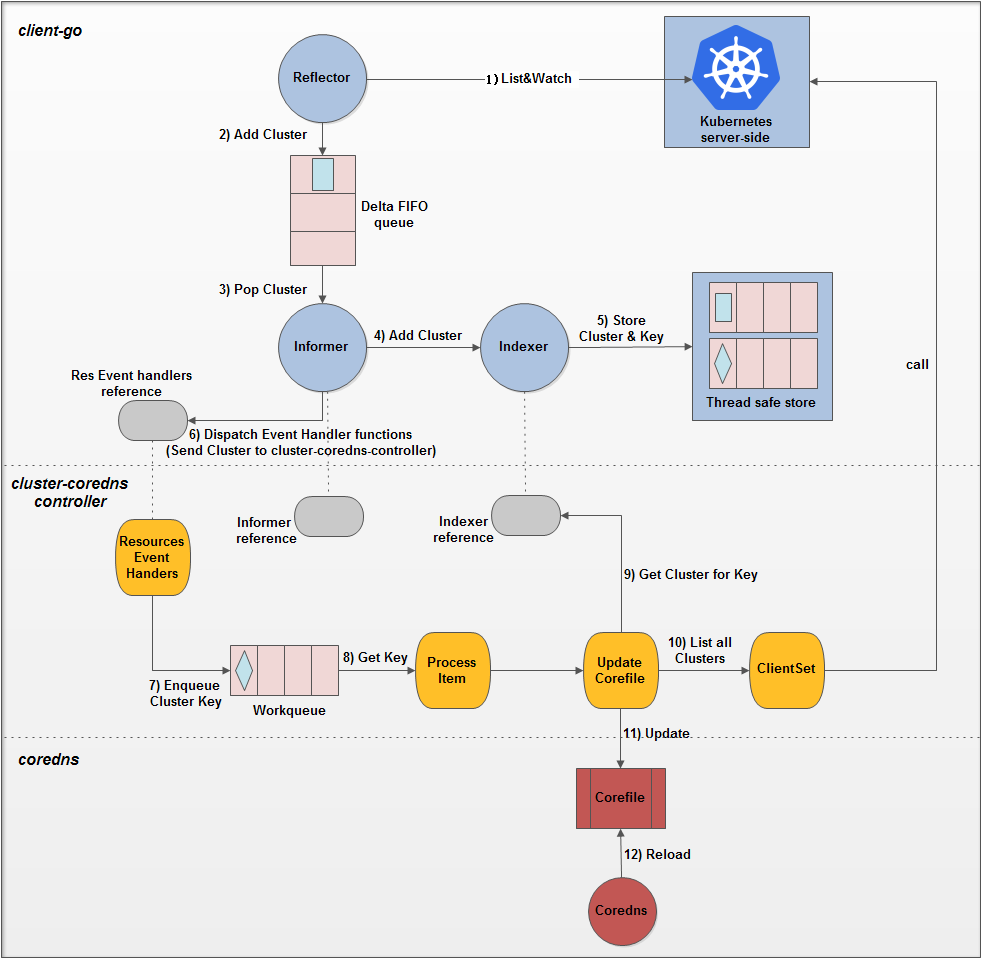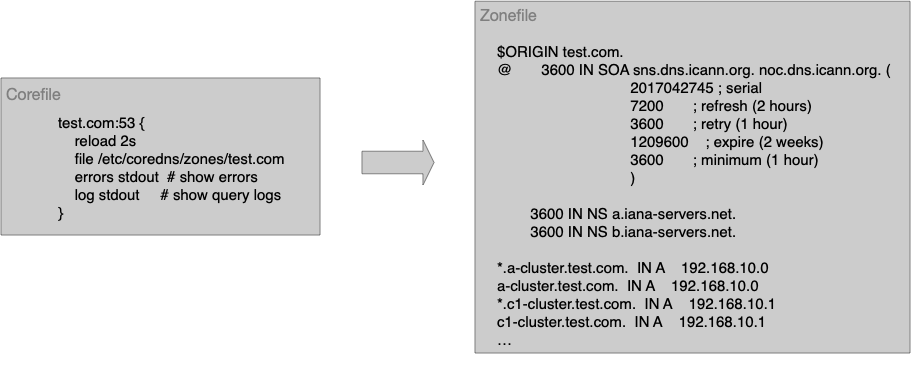This repository implements a tke-cluster coredns controller which helps to synchronize dynamic cluster domains as defined in TKE-Platform Aggregated API Server to coredns, and customers can have access to all of the ingress of both admin and custom clusters through one coredns.
cluster-coredns-controllershares disk with coredns(running on the same machines).- coredns needs to enable file and reload plugins(both of them are internal plugins and compiled into the default CoreDNS).
- the ingress hosts of both
adminandcustomclusters are suffixed byTKE cluster name+wildcardDomainSuffix(for example, xxx.cluster-a(cluster-name).com(wildcardDomainSuffix)).
The cluster-coredns-controller is a kube-like controller(refer to sample controller) which watches the Kubernetes API for the TKE Cluster and synchronizes dynamic cluster domains to coredns by updating the Corefile and relevant Zonefile. The principle of cluster-coredns-controller is similar to ingress-nginx-controller and can be illustrated as follows:
The details of interaction points of the cluster-coredns-controller with TKE kubernetes and coredns show below(refer to client-go under the hood):
As coredns uses Declarative Configuration, the cluster-coredns-controller will list all TKE clusters and modify the Corefile and relevant Zonefile appropriately for dynamic cluster domains whenever it receives an event of cluster from kubernetes:
- domain ADD: add relevant cluster zone item to the Zonefile and update the Corefile
- domain DELETE: delete relevant cluster zone item from the Zonefile and update the Corefile
- domain UPDATE: update relevant cluster zone item in the Zonefile and update the Corefile
cluster-coredns-controller makes coredns use reload plugin once per Server Block, which allows automatic reload of a changed Corefile. After these changes, coredns will reload the Corefile and validate it, and finally customers can have access to relevant TKE kuberentes services by ingress.
cluster-coredns-controller can be run outside of the kubernetes as below:
$ bash hack/start.shAnd in this situation, you may need to keep it high-available by some means.
Running cluster-coredns-controller inside a kubernetes is more convenient compared with the external as kubernetes daemonset helps to keep it high-available:
# generated image
$ make dockerfiles.build
# retag and push to your docker registry
$ docker tag duyanghao/cluster-coredns-controller:v2.0 xxx/duyanghao/cluster-coredns-controller:v2.0
$ docker push xxx/duyanghao/cluster-coredns-controller:v2.0
# Update the daemonset to use the built image name
$ sed -i 's|REPLACE_IMAGE|xxx/duyanghao/cluster-coredns-controller:v2.0|g' examples/daemonset/daemonset.yaml
# create configmap
$ kubectl apply -f examples/daemonset/configmap.yaml
# create cluster-coredns-controller daemonset
$ kubectl apply -f examples/daemonset/daemonset.yamlThe following table lists the configurable parameters of the cluster-coredns-controller and the default values.
| Parameter | Description | Default |
|---|---|---|
| ClusterServerCfg | ||
clusterServerCfg.masterURL |
The address of the Kubernetes API server. Overrides any value in kubeconfig. | https://tke-platform-api |
clusterServerCfg.kubeConfig |
Path to a kubeconfig. | /app/conf/tke-platform-config.yaml |
clusterServerCfg.enableEvent |
Whether to create event broadcaster. | false |
| coreDnsCfg | ||
coreDnsCfg.corefilePath |
Path to Corefile of coredns | /etc/coredns/Corefile |
coreDnsCfg.zonesDir |
Directory of zones | /etc/coredns/zones |
coreDnsCfg.wildcardDomainSuffix |
wildcardDomainSuffix of Cluster | |
coreDnsCfg.interval |
Interval of coredns reload(s) | 2 |
HEAD of this repository will match HEAD of tkestack/tke.


